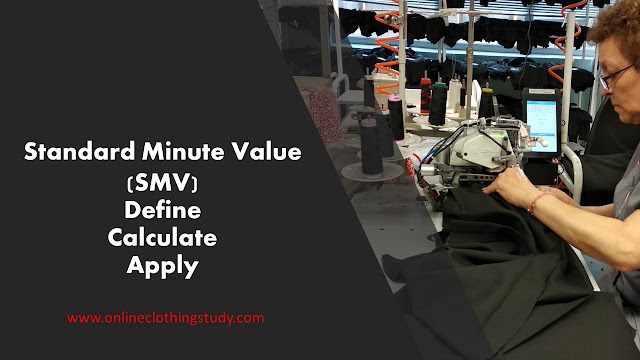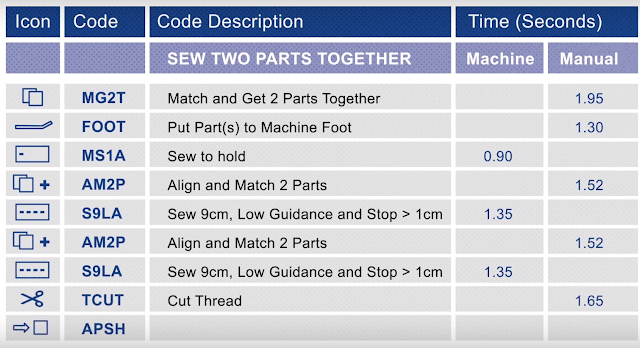There is no more secret in Standard Minutes Value (SMV) calculation. Now, SMV is a common language between fashion brands and manufacturers for discussions on cost, time and floor capacity. Most of the garment manufacturing companies calculate the SMV of their garments. Industrial engineers take responsibility for measuring standard time for the given garment samples. Let me define SMV, the most critical factor, widely used and much talked about term in the garment industry.

- This definition is written in the ILO work study book.
Operation cycle time or average time, taken by an operator completing an operation is not the Standard minute value. SMV is the given time that should be taken to complete operation if she works at 100% performance level. SMV of the same operation will be different if the working condition is changed – like operator using a different machine, the operator sews a bigger component, an operator using attachment and work-aids when sewing a garment. Most importantly, movement and motions involved in performing a task.
In time study, you capture the observed time of the selected operation. You rate operator performance in the work. You use standard allowances for different types of machines, bundle allowance and contingency allowances.
Steps for calculating SMV
1. Record observed time.
Following the Time Study procedure, you conduct Time Study for a selected operator and on the selected operation.
2. Convert observed time into Basic time using this formula.
The observed time for the same operation done by two different operators might be different. Our objective is to establish the standard for the selected operation. So, for the levelling of the observed time, it is multiplied by the rating factor. The new time is called as basic time.
When an operator will be working there would be changes of a machine breakdown, they may need to change the needle, replace empty bobbin, change thread spool, may need of threading needle. There will be personal needs and fatigue allowance. For all these allowances, some amount of time will be consumed from the operator’s standard time. To estimate more practical SMV allowances are added to the basic time.
Normally, in progressive bundle system, garment components reached to an operator in bundle form. For every bundle, the operator spends a few minutes in opening the bundle and tying it. So, you need to add bundle allowance as well where applicable.
4. Calculate Standard minute
Add machine allowance, bundle allowance and other allowances to the basic time to calculate standard minute.
Also, note that bundle allowance is distributed across the pieces in a bundle. If bundle allowance is 60 seconds for a 10 pieces bundle, bundle allowance would be added as 6 seconds to the basic time.
Example: Let’s say you are making a blouse. You observed an operation and record its cycle time. Following the above steps let’s derive SMV of an operation.
In the operation bulletin, after measuring operation SMV, hourly and daily production capacity is calculated. For further study on the capacity calculation, machine requirement calculation, check this post.
The Second method
The second method of establishing SMV is using PMTS software. For this method, you need to know different motion codes and you need to study real-life operator hand and body movement. You need to learn how to operate software for calculating sewing operation SMV. Once you learn that you can measure SMV for any kind of operations whether it is cutting, pressing, sewing, folding etc. (Essential thing you must have the software).
For your reference, establishing SMV using PMTS software, steps are shown in this post.
Also Read: Few important facts of Standard Minute Value (SMV)
Cycle Time: It the time actually taken by an operator at the work. Cycle time is measured from the time stamp of pick-up of the garment component to the next pick-up time stamp of an operation cycle. The starting point of an operation cycle can be chosen by the engineer. Normally the cycle time value is higher than the standard time.
Observed time: Here observed time is the same as the cycle time. The time recorded as it was and operation cycle time calculated.

Definition of Standard Minute Value
Standard Minute is the time value arrived at for a task based on the average rate of output which qualified workers will naturally achieve without over exertion provided that they know and adhere to the specified method and provided that they are motivated to apply themselves to their work.- This definition is written in the ILO work study book.
Operation cycle time or average time, taken by an operator completing an operation is not the Standard minute value. SMV is the given time that should be taken to complete operation if she works at 100% performance level. SMV of the same operation will be different if the working condition is changed – like operator using a different machine, the operator sews a bigger component, an operator using attachment and work-aids when sewing a garment. Most importantly, movement and motions involved in performing a task.
SMV calculation method
You can calculate garment SMV using SMV calculation software or through time study method. Standard minute value calculation method using Time Study is explained in this article with an example. First, you measure operation wise SMV. Then SMV of all operations in style are combined to calculate total SMV of a garment.In time study, you capture the observed time of the selected operation. You rate operator performance in the work. You use standard allowances for different types of machines, bundle allowance and contingency allowances.
Steps for calculating SMV
1. Record observed time.
Following the Time Study procedure, you conduct Time Study for a selected operator and on the selected operation.
2. Convert observed time into Basic time using this formula.
The observed time for the same operation done by two different operators might be different. Our objective is to establish the standard for the selected operation. So, for the levelling of the observed time, it is multiplied by the rating factor. The new time is called as basic time.
Basic Minute =(Observed time in minute x Performance Rating)3. Know the applicable allowances.
When an operator will be working there would be changes of a machine breakdown, they may need to change the needle, replace empty bobbin, change thread spool, may need of threading needle. There will be personal needs and fatigue allowance. For all these allowances, some amount of time will be consumed from the operator’s standard time. To estimate more practical SMV allowances are added to the basic time.
Normally, in progressive bundle system, garment components reached to an operator in bundle form. For every bundle, the operator spends a few minutes in opening the bundle and tying it. So, you need to add bundle allowance as well where applicable.
4. Calculate Standard minute
Add machine allowance, bundle allowance and other allowances to the basic time to calculate standard minute.
Standard Minute Value = (Basic minute + Bundle allowances + machine allowance + personal fatigue allowances).Normally, when SMV is measured through time study method, the operation cycle is broken down into operation elements and observed time is captured element-wise. Machine allowances are added only to machine elements.
Also, note that bundle allowance is distributed across the pieces in a bundle. If bundle allowance is 60 seconds for a 10 pieces bundle, bundle allowance would be added as 6 seconds to the basic time.
Example: Let’s say you are making a blouse. You observed an operation and record its cycle time. Following the above steps let’s derive SMV of an operation.
- Observe Time = 2 Minutes
- Rating of the operator = 90%
- Basic Time = (2 Minutes x 90%) = 1.8 Minutes [Why multiply Rating factor?]
- Machine allowance =10%
- Other Allowance = 10%
- Total allowance to add = 10% + 10% = 20%
- Allowance in minutes = 1.8 x 20% = 0.36 Minutes
In the operation bulletin, after measuring operation SMV, hourly and daily production capacity is calculated. For further study on the capacity calculation, machine requirement calculation, check this post.
The Second method
The second method of establishing SMV is using PMTS software. For this method, you need to know different motion codes and you need to study real-life operator hand and body movement. You need to learn how to operate software for calculating sewing operation SMV. Once you learn that you can measure SMV for any kind of operations whether it is cutting, pressing, sewing, folding etc. (Essential thing you must have the software).
 |
| A presentation of standard time calculation using motion codes | Image source: YouTube/GSDCost |
For your reference, establishing SMV using PMTS software, steps are shown in this post.
Also Read: Few important facts of Standard Minute Value (SMV)
SMV calculation Software
If you want accurate SMV of garment (and other sewn product), you need a software to calculate the SMV. Most of the SMV calculation software uses motion codes and predetermined times. Few of the well-known SMV calculation software included- GSDCost
- SewEasy
- ProSMV
- TimeSSD
Application of SMV (SAM value)
I have listed a few of the application of garment SMV.
- SMV is used in factory capacity planning
- SMV is the main data in the operation bulletin. Based on the operation SAM machine requirement and manpower requirement is calculated. Further based on the machine requirement machine layout and initial line balancing is done.
- SMV is used for labour costing for garment production
- SMV is used for performance benchmarking
- SMV is used for efficiency calculation
- SMV is used in Payroll calculation in piece rate payment. Earning is equal to garment produced x operation SMV x rate per minute
- When performance incentive is provided to the operators, SMV is essential for calculating individual operator efficiency
- Preparing operators’ performance-based skill matrix
- Who is responsible for calculating garment SMV in a garment factory?
Definition of different terms used in SMV calculation process
Rating factor: Rating is a subjective comparison of any condition or activity to a benchmark, based upon our experience. While the mechanics of time study record the time a task did take, applying a rating will determine the time a task should take. Read the concept of performance rating.Cycle Time: It the time actually taken by an operator at the work. Cycle time is measured from the time stamp of pick-up of the garment component to the next pick-up time stamp of an operation cycle. The starting point of an operation cycle can be chosen by the engineer. Normally the cycle time value is higher than the standard time.
Observed time: Here observed time is the same as the cycle time. The time recorded as it was and operation cycle time calculated.

Post a Comment